
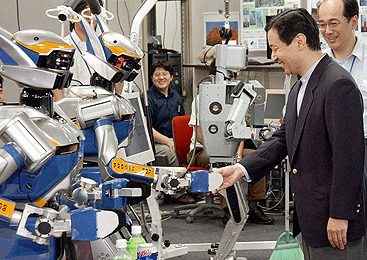
Kawada Industries' metallic marionette HRP-2, or Promet, was built to assist the hands-on replication of individual and cooperative human movements but a soaring profile broadened the robot's purpose, having won an audience with heir apparent to Japan's titular throne, Prince Naruhito. Promet's program must have successfully adopted the niceties of Imperial reception, for the meeting at Tokyo University was reported in the news and the physiological difference between synthetic and organic was duly noted:
[Naruhito] let the robot take several steps toward him to shake his hand, as other humanoids looked on.
Who would pass up a retinue hard-wired for plaudits? Nobody, least of all those who trade in public opinion futures. One wonders if enterprising members of Japan's Liberal Democratic Party, off-balance after failing in the Diet to authorize Prime Minister Junichiro Koizumi's postal privatization reform, are furtively peeking into robotics laboratories — asking questions about the design and deployment of progressive, selfless and loyal politicians for the House of Councillors.
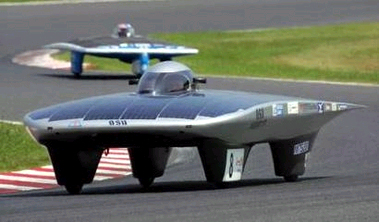
Form follows function, so the multinational visionaries who designed, built and jockeyed solar hot-rods should be proud of the irregular fleet of flattened cupcakes scuttling like oversized dollar-store toys on Japan's Suzuka Circuit at Federation Internationale de l'Automobile's Alternative Energies Cup and Dream Cup race in the name of science. Proving the endurance of vehicles powered by Sol's renewable resources, the eight-hour event was a Jetsons' mockup of the Grand Prix, trading the sexily abrasive roar of internal combustion for the dignified wonderment of an epicene, electric flit. There were adoring fans, breakneck straightaways, pit teams and a requisite champagne dousing at the awards ceremony for champion Ashiya University Solar Car Project A. In its fourteenth year, the Dream Cup met its correspondingly economical objective, "making eco-friendly automobiles." Making them a commercial reality? — no, but surely a curious attraction. Did a robot wave the checkered flag? No? Maybe next year.

August is sunflower season in Yamanashi Prefecture and for natives and tourists alike, Akeno Village is said to yield two hundred and fifty thousand of the majestic plants for an annual festival. Judging by photographs documenting the attraction over the last several years, visitors seem compelled to brave the botanic crowd that is an enormous sunflower field just nearby the Akeno Flower Center, and commune with nature by being swallowed by it.

Japan's affinity for colloquial, aquatic creatures is as well-known around the world as it is documented on uBlog (namely here, here and here). Tokyo's Hakkeijima Sea Paradise hosts the Beluga Whale, a chatty underwater beast dubbed the "sea canary" for its acrobatic vocal chords and irrepressible urge to sing, sing, sing. This specimen of Delphinapterus leucas appears to take all manner of requests. Crosby? Armstrong? Martin? Fitzgerald? Just about anything — short of keeping quiet.
It may interest you that RoboCup 2005, a robotics and artifical intelligence competition held in the name of designing life-size automatons capable of defeating a human soccer team by 2050, took place in Osaka this past week. Sponsored by nearly twenty major Japanese firms, the event pitted over three hundred teams from thirty-one countries in a dozen mechanized matches. Judging by a nonchalant reference to the robot team's opponents as champions of the "World Cup of Human Soccer" forty-five years hence, kicking balls into goals by other means has come quite a ways since Subbuteo.
And it may interest you that the HAL-5 mechanical exoskeleton, spied by uBlog last month, continues to impress and inspire those eager to supplement Japan's workforce with droids and bionic men.
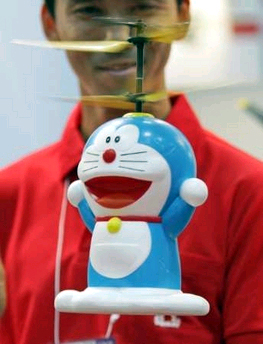
All of that may interest you, but perhaps less so than the fetching Doraemon helicopter that can be had for fifty dollars. Priorities, priorities.
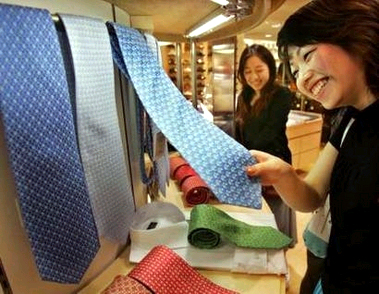
For its sagacity and legislative advances in policies both domestic and international, Japan yet subscribes to fractured doctrines of the last century — a belief in global warming on account of man the most peculiar and intrusive of them. Resting on a scientific basis as ungainly as that of every American twenty-something's fourth or fifth grade teacher, Tokyo chose the month of June to launch a campaign dubbed "Cool Biz," inviting the nation's shopkeepers and executives to keep employees' high collars, long sleeves and ties at home for the summer. Workers with less clothes could stand a warmer office and reduce carbon dioxide emissions from air-conditioners which, through the convoluted reasoning of pseudo-science, must somehow be affecting a planet whose climate has changed drastically and repeatedly without the help of modern industry.
Politics aside, "Cool Biz" has impressed neither companies with faith in uniform nor those who furnish business attire.
If not for the officious public advice and the private sector's reluctant tap dance, however, we may not have been able to learn from a string of informally polled businessmen just how thoroughly Japanese professional propriety has resisted the West's inexorable trend to formal-casual:
Employees of TEPCO put a business card-sized badge on their chests that says, "Excuse me for being casually dressed," in consideration that some customers might be offended by their casual attire. On the other hand, many workers say they feel uneasy wearing the light attire."When I have to meet customers older than me, I feel uncomfortable," an NTT East Corp. employee said. ...Even employees of companies that encourage them to dress lightly reportedly wear a tie when they leave home to avoid looking too casual in front of their neighbors and take it off when they arrive at the office.
Bless the button-down — and its accidental challenge.

Hello Kitty is a fundament of Japanese pop culture and therefore a recurring character on uBlog's wide-eyed stroll through the North Pacific island wonderland, Only in Japan. Toymaker Sanrio recently decided to wed their lady to the ancient world, constructing a chess set in the darling feline's likeness:
Hello Kitty, the moon-faced, mouthless white cat which comes on dolls, credit cards, laptops and vacuum cleaners as a global icon of cuteness has now advanced into the world of chess. Unlike the staid traditional black and white, the two camps facing off on the Hello Kitty chessboard are pastel pink and blue...."We started with mail-order as we do not know how much demand we will see," a Sanrio official said.
Modesty. Were Anderssen and Kieseritzky alive today, we might be calling their duel the "Immortal and Highly Marketable Game."

Our fascination with Japan's fascination with robots continues. The Expo 2005 Prototype Robot Exhibition in Aichi Prefecture ended on Sunday after eleven days of synthetic marvel — from dancers to companions, surveyors to guides, laborers to entertainers, musicians to simulacrums, the Exhibition presented sixty-three robots and countless possibilities. Alongside the hardwired societal hopefuls were the ethical, aesthetic and metaphysical questions that have followed robotics through decades of straddling science and science fiction. When is a robot a supplement and a welcome substitute? When does it displace a human being who could and should have undertaken the task it performs? Are programming flaws worth the trade for man's emotional shortcomings?
 One of the robots, Kawada Industries' humanoid HRP-2, played a wadaiko based on the movements of a master percussionist like a MIDI driver might execute a sequenced musical score. Nicknamed "Promet" by its body designer, animé oldhand Yutaka Izubuchi, HRP-2 is a personified study in bipedal robotic agility, equilibrium, recovery and cooperative physical activity. Kawada intends to "rent" HRP-2 out to private and public designers alike, "a humanoid robot R&D platform" that sounds remarkably like an open-source arrangement. The Expo drum performance, likely intended for the headlines and pool photographs it duly received, does pose an interesting challenge to the human sense of musical rhythm and tempo. Mechanical timekeeping is nothing new: since the introduction of commercially available sequencers in the early 1980s, music — especially pop — has almost completely conformed to a standard of quantization, or the limitation of musical time values to a discrete set. Just as high compression is today's familiar and requisite sound, consumers' ears have grown accustomed to steady beats. A bubblegum tune without a dozen dance hall remixes is a song that will not sell, and remixing is practically impossible with arbitrary tempo fluctuations.
One of the robots, Kawada Industries' humanoid HRP-2, played a wadaiko based on the movements of a master percussionist like a MIDI driver might execute a sequenced musical score. Nicknamed "Promet" by its body designer, animé oldhand Yutaka Izubuchi, HRP-2 is a personified study in bipedal robotic agility, equilibrium, recovery and cooperative physical activity. Kawada intends to "rent" HRP-2 out to private and public designers alike, "a humanoid robot R&D platform" that sounds remarkably like an open-source arrangement. The Expo drum performance, likely intended for the headlines and pool photographs it duly received, does pose an interesting challenge to the human sense of musical rhythm and tempo. Mechanical timekeeping is nothing new: since the introduction of commercially available sequencers in the early 1980s, music — especially pop — has almost completely conformed to a standard of quantization, or the limitation of musical time values to a discrete set. Just as high compression is today's familiar and requisite sound, consumers' ears have grown accustomed to steady beats. A bubblegum tune without a dozen dance hall remixes is a song that will not sell, and remixing is practically impossible with arbitrary tempo fluctuations.
At the same time, some minimalist compositions of the late Twentieth Century, particularly those of Steve Reich, are both aurally and theoretically compelling precisely because they are live performances on traditional instruments of music normally associated with — and relegated to — synthesizers and sequencers. Metronomic and repetitive, a Reich piece like the 1970 Drumming would fail if produced electronically; on marimbas and glockenspiels, it is a seventy-minute masterpiece, wholly dependent on the happy medium between human consistency and imperfection. A friend's old college classmate was recently praised by Reich for the "tightest performance" of Music for 18 Musicians the composer had ever attended. Run through a computer there would have been no tension, no risk — and excitement is a difficult element to code. Digital clocks may prevail in the making of organized sound but the subtle judgment that brings nuance, as Kawada's HRP-2 project demonstrates, is yet beyond replication.
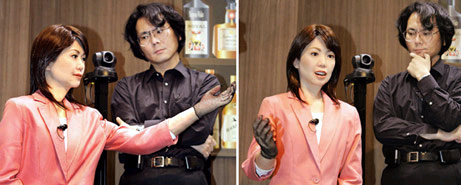
Which is not to say that robotics designers are absent their share of little victories:
Repliee Q1 appeared yesterday at the 2005 World Expo in Japan, where she gestured, blinked, spoke, and even appeared to breathe. Shown with co-creator Hiroshi Ishiguru of Osaka University, the android is partially covered in skinlike silicone. Q1 is powered by a nearby air compressor, and has 31 points of articulation in its upper body. Internal sensors allow the android to react "naturally." It can block an attempted slap, for example. But it's the little, "unconscious" movements that give the robot its eerie verisimilitude: the slight flutter of the eyelids, the subtle rising and falling of the chest, the constant, nearly imperceptible shifting so familiar to humans.
Or ethical dilemmas. How soon until Nexus 6?
UNCANNY: Repliee in motion.
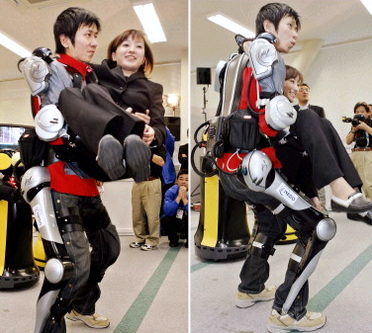
We begin with a lede and an exhilarating non sequitur:
Japan has taken a step into the science-fiction world with the release of a "robot suit" that can help workers lift heavy loads or assist people with disabilities climb stairs."Humans may be able to mutate into supermen in the near future," said Yoshiyuki Sankai, professor and engineer at Tsukuba University who led the project. ...The prototype suit will be displayed at the World Exposition that is currently taking place in Aichi prefecture, central Japan.
Physiological transcendence aside, mechanical exoskeletons have titillated sci-fi writers, readers, audiences and gamers for the better part of three decades. Christened HAL-5, the suit can both augment and stimulate locomotion, aiding the feeble and convalescent. It might even save nerds who suffer the silica-kicks of beach bullies several months of the Charles Atlas method — winning them a chance for a girl like Partner Ballroom Dance Robot, or PBDR, also at Aichi:
Japanese scientists have created a dancing robot for lonely ballroom dancers short of a partner to hit the floor with. The Partner Ballroom Dance Robot can predict the dance steps of its human partner to glide effortlessly across the room, reports Sky News.
The robot, which uses a sensory devise under its ballgown to follow its companion's steps, moves with the help of three wheels, also located under its dress. Apart from its mouse-like-ears, the android takes the form of a woman's figure, but potential partners should be warned that the robot is not light on its feet.
At 5ft 4in tall and weighing in at some 16 stone, this dance partner could inflict some pretty serious damage if it treads on your toes.
And if the evening goes sour, a slap that could likely knock a man across the floor. Still, your own monochromatic, metal-plastic composite Ginger Rogers would be a prize at a dance marathon. Do androids dream of electric fleet feet? Ask the Japanese. (Special thanks to Jonn Sokol.)

Reuters is furtively trying to tell us something.
According to Japan's Yomiuri Shimbun, the country's historically sluggish postwar birthrate has dropped even further. Now, while that may deflect histrionics from overpopulation alarmists it's done nothing to ease concerns of public policymakers:
The ongoing decline in the birthrate could mean future labor shortages as well as difficulties in funding state pensions. The ministry said the current public pension system, under which younger workers support pensioners, is unsustainable and the government may be forced to reduce pension benefits or increase premiums.
How did Reuters choose to illustrate the story? — with a lion leaning in on a watchful toddler. There's the slightest intimation that births are steady but monster-gobbling is up. A second Health, Labor and Welfare Ministry study, perhaps?
